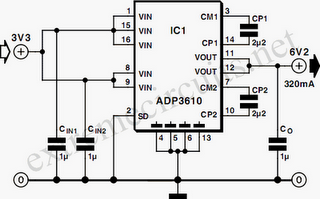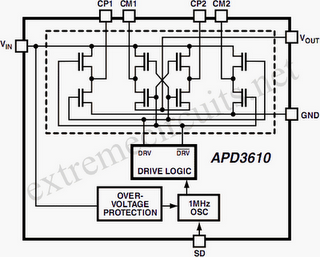Home » Circuits
Switching Voltage Regulator
The Analog Devices ACP3610 is a voltage doubler that works with a switched-capacitor converter, using the push-pull principle. The switching frequency at the output is approximately 550 kHz. The term ‘push-pull’ refers to the two charge pumps, which work in parallel but in opposite directions in order to deliver the output voltage and current. Whenever one capacitor is supplying current to the output, the other one is being charged. This technique minimizes voltages losses and output ripple. The converter works with input voltages between 3 and 3.6 V. It provides an output voltage of around 6V at a maximum current of 320mA, if 2.2µF switched capacitors with low ESR (equivalent series resistance) are used. A shut-down input is provided to allow the voltage doubler to be enabled or disabled by a logic-level signal. The IC is enclosed in a special package, which can dissipate up to 980mW at room temperature. The schematic diagram shows a typical application for the ADP3610. Here it works as a non-regulated voltage doubler. In theory, a voltage doubler can provide exactly twice the input voltage at its output, but in practice the combination of internal losses in the electronic switches and the internal resistances of the capacitors always causes the output voltage to be somewhat lower. The output voltage drops from a no-load value of 6 V to 5.4 V with a 320mA load, with a nearly linear characteristic.
A shut-down input is provided to allow the voltage doubler to be enabled or disabled by a logic-level signal. The IC is enclosed in a special package, which can dissipate up to 980mW at room temperature. The schematic diagram shows a typical application for the ADP3610. Here it works as a non-regulated voltage doubler. In theory, a voltage doubler can provide exactly twice the input voltage at its output, but in practice the combination of internal losses in the electronic switches and the internal resistances of the capacitors always causes the output voltage to be somewhat lower. The output voltage drops from a no-load value of 6 V to 5.4 V with a 320mA load, with a nearly linear characteristic.
 A small capacitor is connected across the two supply pins at the input of the IC. It suppresses noise, brief voltage fluctuations, and current peaks when the ADP3610 switches. This capacitor (CIN) must have a low internal resistance (ESR). A larger capacitance value is necessary if long supply leads to the ADP3610 are present. The 1µF output capacitor (CO) is alternately charged by the two capacitors of the charge pump, CP1 and CP2. The internal resistance is an important factor here as well. It largely determines the amount that the voltage drops under load, and the amount of ripple in the output voltage. Ceramic or tantalum capacitors are recommended. The ESR can also be reduced by connecting several smaller-value capacitors in parallel. With small loads, the value of CO may be reduced.
A small capacitor is connected across the two supply pins at the input of the IC. It suppresses noise, brief voltage fluctuations, and current peaks when the ADP3610 switches. This capacitor (CIN) must have a low internal resistance (ESR). A larger capacitance value is necessary if long supply leads to the ADP3610 are present. The 1µF output capacitor (CO) is alternately charged by the two capacitors of the charge pump, CP1 and CP2. The internal resistance is an important factor here as well. It largely determines the amount that the voltage drops under load, and the amount of ripple in the output voltage. Ceramic or tantalum capacitors are recommended. The ESR can also be reduced by connecting several smaller-value capacitors in parallel. With small loads, the value of CO may be reduced.
